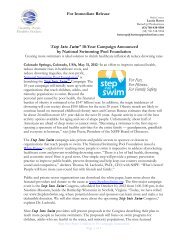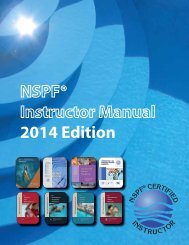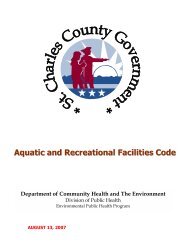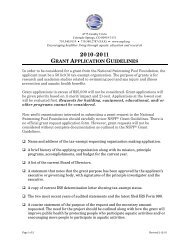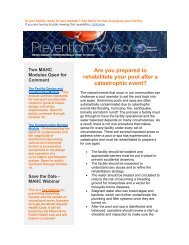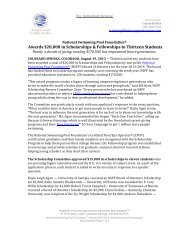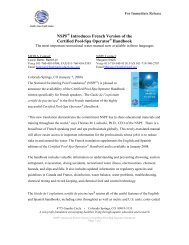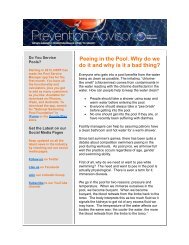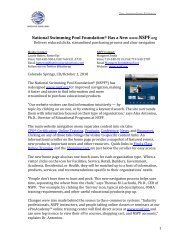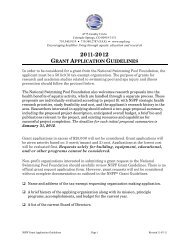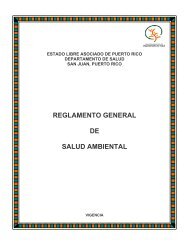English Instructor Manual (PDF) - Metric Version - National ...
English Instructor Manual (PDF) - Metric Version - National ...
English Instructor Manual (PDF) - Metric Version - National ...
You also want an ePaper? Increase the reach of your titles
YUMPU automatically turns print PDFs into web optimized ePapers that Google loves.
Chapter 3 – Essential Calculations<br />
Handbook: Pages 23 - 32<br />
Suggested Time:<br />
PowerPoint Slides:<br />
Materials:<br />
60 minutes<br />
Chapter 3 Slides<br />
Calculation Formulas handout (Appendix J from <strong>Instructor</strong> <strong>Manual</strong>)<br />
Pool Math Workbook<br />
Calculator<br />
Objectives: At the end of this lesson, the student will be able to:<br />
1. Convert ounces to pounds, and fl uid ounces to gallons.<br />
2. Convert inches to feet, meters to feet, and yards to feet.<br />
3. Calculate surface areas for a rectangular or circular shaped pool.<br />
4. Calculate water volume for a rectangular or circular shaped pool.<br />
5. Calculate water volume for a multi-dimensional aquatic facility.<br />
Leading Question:<br />
Why is it important for pool operators to be able to convert small measures (grams and<br />
milliliters) into larger measures (kilos and litres)?<br />
Activity: Explain that being able to convert small measures into larger measures is important for<br />
such things as purchasing chemicals. For example, imagine what it would be like to go to a pool<br />
store and request 21,000 grams of a chemical. The response may be anything except what we<br />
want. Instead, if we request 21 kilos of a chemical, we are liable to get a totally different response.<br />
The amount is the same. The response to our request is totally different.<br />
Using the Calculation Formulas handout, demonstrate how to convert grams to kilos, and<br />
millileters to litres. Have participants perform several amount conversion calculations under your<br />
supervision and guidance.<br />
Leading Question:<br />
Why is it important for pool operators to be able to convert various measures of<br />
distance?<br />
Activity: Explain that being able to convert various measures of distance into one common<br />
measure is important to perform various calculations such as surface areas and water volumes.<br />
In metric terms the fi nal distance measurement must be in meters..<br />
Leading Question:<br />
Why is being able to calculate surface areas important?<br />
Activity: Explain that being able to calculate surface areas is important because we use surface<br />
areas in many aspects of pool operation and maintenance. For example, if we want to paint our<br />
© 2014 <strong>National</strong> Swimming Pool Foundation® Page 47



